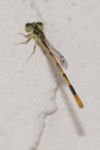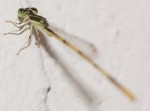Last week I started to notice the persistent presence in these here parts of those ephemeral and infernally hard to see odonates, the damselflies. Two forktail species, Rambur’s and Citrine, (Ischnura ramburii and I. hastata, for those of you keeping score at home) are the only ones present so far, but I’m sure that soon I’ll see the bluets again.
I’m generally only able to go out on photo safari during the lunch hour (I do have a day job, after all), and I’ve found that the local damselflies are pretty wary in the middle of the day. But the other afternoon I was able to sneak up on one bright yellow male Ischnura hastata (Citrine Forktail); it was quiescent enough to allow me to discover the effects of depth of field on odonate photography. These animals are small, but in macro photography, small distances matter.
As Sid Dunkle, coauthor of the recent monographic guide to the damselflies points out, depth of field is critical to successful odonate photography. In the photographic Supplement to Damselflies of North America, the standard treatment of the zygoptera, Dunkle writes that
I have had the near eye and the tip of the abdomen of a damselfly in focus, but the near surface of the thorax was out of focus! … The film plane [or in my case, the CMOS chip] must be aligned exactly with the longitudinal axis of the body to get both head and tip of abdomen in focus. A lot of patience is needed!
In my case, patience was needed simply to approach these maddeningly elusive little beasts. I say maddening because one would expect that a relatively large and slow-flying animal like this would be pretty easy to keep track of once spotted. But nothing could be further from the truth. It might just be my aging eyes, but I found it quite difficult to keep my eye on these little buggers as they flew from brightly lit areas to shade, and from grass stem to grass stem. At times I found it easier to track them by their shadows than by their actual bodies!
But once you get a damselfly quiet, it is indeed possible to approach them closely enough to capture some successful photographs, as the gallery below indicates. It’s also possible to discover just how critical focusing is in macro photography.
I took many more than seven photos, of course; these are just the ones that are anywhere close to being keepers, or that can serve as instructional reminders for myself.







